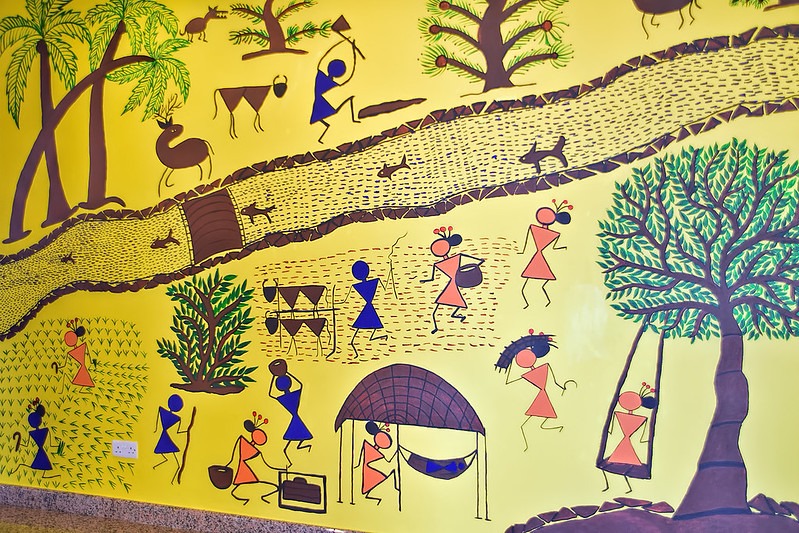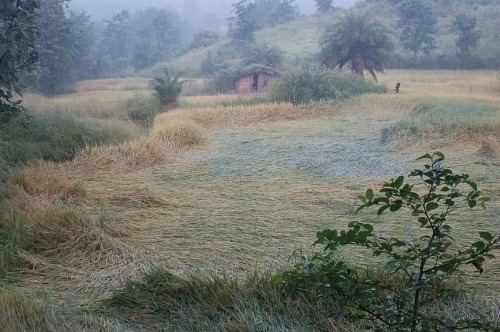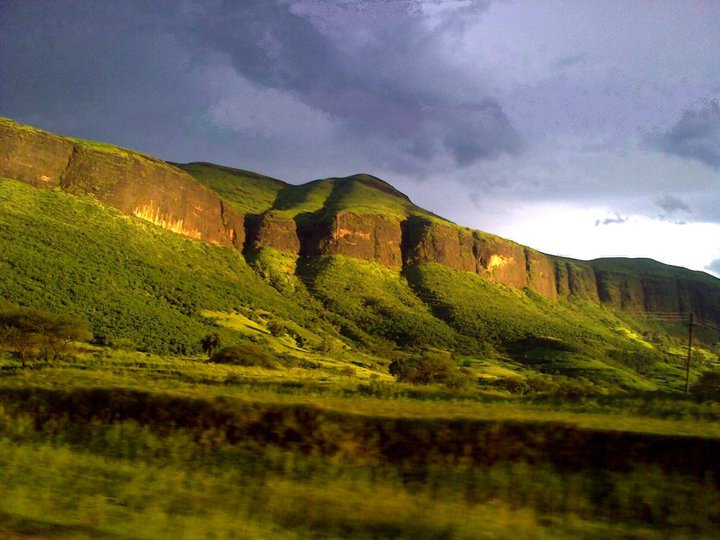I have always wondered how so many things happen just before us, and we never even notice. Kind of like when you are looking for something you can’t find, and you call for your mom, and it turns out it was right there in front of you all along. This thought was reiterated to me recently on my trip to Bangalore. I had booked a Savaari from Mumbai. It was when I was visiting my friend who lives in Malleshwaram, and in true Bangalorean fashion, we got seduced by the weather outside to go for a walk. I noticed this beautiful white graffiti on the walls. It looked like stick figures but made with triangles and circles.
My friend told me that the BBMP, in collaboration with ‘Let’s Be the Change’, got them painted. It didn’t take long for me to face how often I have seen this kind of art. To give you a little context, my mother has drapes with warli art on them, a painting hangs in the library where I usually go, I have earrings shaped like people from warli art, and the list goes on. A quick google search told me that this kind of art is called warli, and it is most prominent near the Thane region in Mumbai, and that’s when it hit me, I crossed a village called Warli towards the beginning of my trip to Bangalore. Is there a connection between the village I crossed and the art form?
Warli Art- The modern cave paintings
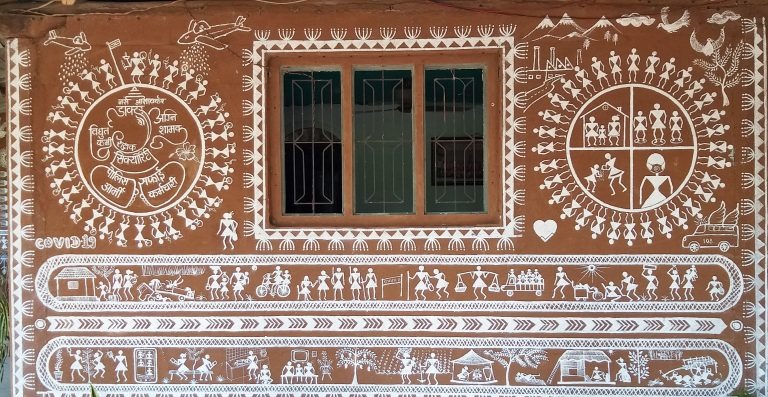
As the questions about the connection between art and the village kept me awake, I decided to get to the bottom of this intrigue. It didn’t take long for me to find that warli art is practised by the people of a vast tribe called the Warli (Varli) tribe on the outskirts of Maharashtra. It felt terrible knowing that the flair so beautiful is from your homeland, and you have no idea about it. The origin of warli paintings can be traced back to the 10th century A.D. but only received recognition in the 1970s. Only a few people know that warli art is actually an evolved version of art that was painted in the caves of Bhimbetka in Madhya Pradesh as early as 500 BC.
Traditionally, the warli paintings were done on mud walls, with a chewed-up bamboo stick as a paintbrush. The paint comprises rice flour, water and gum, leaving a white pigment on the walls.
The art form is very simplistic in nature and majorly uses only three shapes- triangle, circle and square. What’s more interesting is that the shapes are a derivative of the nature around them. The triangle is based on the shape of the mountains and the conical trees; the circle symbolises the sun and the moon; and the square is the shape of the land believed to be sacred to the tribe due to the importance of agriculture. The people of the tribe believe that time is a cycle which can be seen in their paintings which often have a circular theme. I couldn’t believe the complexity in the ideas and the simplicity of the execution.
I decided that it was time to fix the situation and actually go to warli on my way back from Bangalore. So, I booked my Savaari from Bangalore to Walvanda, home of the Warli tribe, and started on this journey to learn more about the heritage of this beautiful tribe. It was time to decipher bit by bit the elements of the art form and give it the appreciation it deserves.
A tradition of Warli – The art of expression
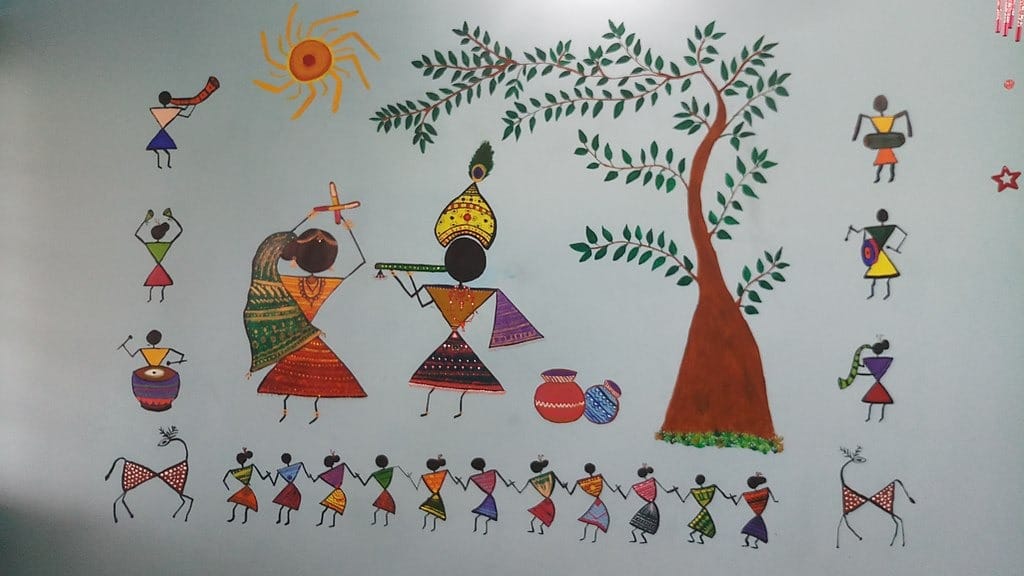
The 16-hour road trip to Walvanda gave me enough time to continue researching the fascinating art form. I pulled some strings and got in touch with Keshav, who lived with the Warli tribe and would be able to show me around and tell me the history of the paintings. As I reached Walvanda, I was in awe and utter disappointment in knowing that a place like this exists so near my house, and I had no idea. We reached the early morning, and I crossed the lush greens of the village with tiny mud huts, all of them doubling down as a backdrop to the warli art.
People were going about their everyday chores, like getting water from the well or feeding the cows, and I could see the inspiration behind the art of the people of the tribe. I called Keshav, and he found me in no time, and we began talking over poha (a Maharashtrian dish made of dry, flaky rice) and a cup of chai.
Keshav told me that the people from the tribe near Thane used to paint as an expression of joy during happy occasions like weddings, harvests or a newborn in the family. It is done to celebrate the auspiciousness of the event and capture the memories. The people of the tribe believe that it evokes the Gods.
Interestingly, the themes of such paintings often depict scenes from the special occasions that call for the painting, like people dancing and playing musical instruments, a scene from the harvest season or a wedding celebration. The people from the tribe seem to be looking outwards when painting these themes. They want to put across the experience of being human and the importance of society in it. It is also believed that the paintings seek communication within and with the outside world. As there is no written language in the tribe, the warli paintings also serve as a way to transfer knowledge through the generations.
When I found that Warli is actually an unwritten language spoken by the people of a tribe from the Sahyadri Range in Maharashtra, I also understood my fascination with the art form. I just had to dig deeper and know more. So, in a way, the warli painting is a way for the tribe to preserve knowledge in the absence of a written language, something like a cave painting.
Styles of Warli – Rituals in art
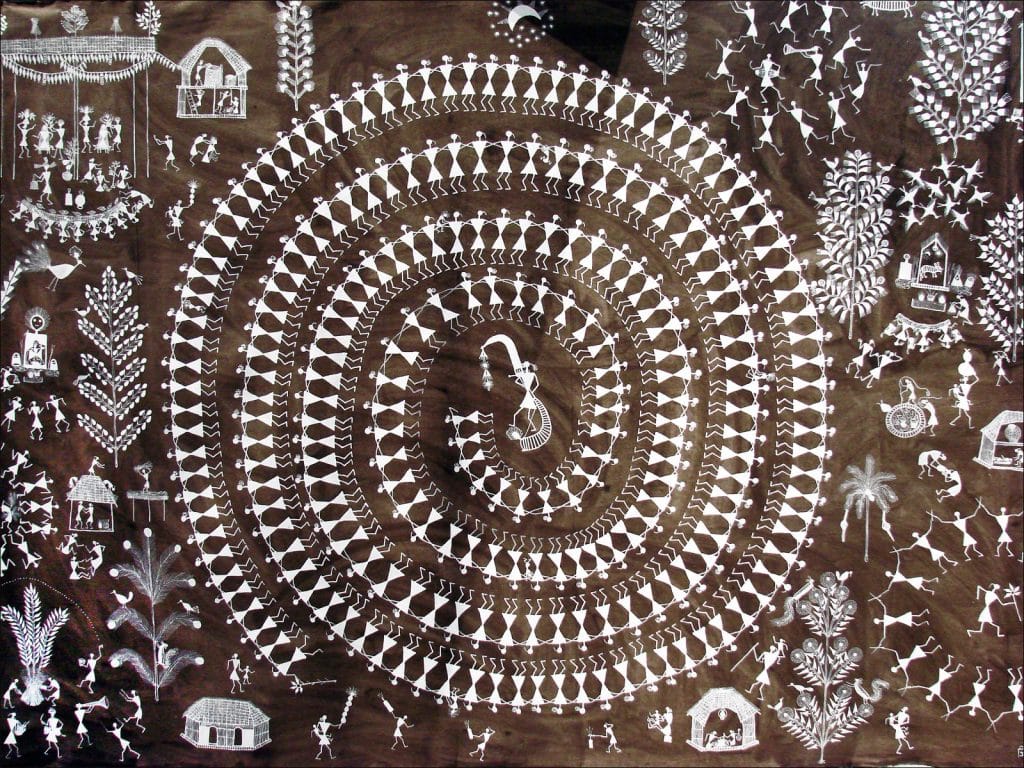
Walking around the village, Keshav started talking to me about the variety and different styles within Warli art. He told me that the theme is usually inspired by nature and village life. You will often find people and animals made from circles and triangles carrying pots or hay on their heads. The lifestyle of the people from the warli tribe is very simple, close to nature and primarily dependent on agriculture, which is very observable in the art. The styles or types of art depend significantly on the occasion of the painting, the symbols used and even who paints it.
On my trip to Walvanda, I got to explore the various styles of warli art.
- Marriage Warli: Marriage is an auspicious occasion, and the painting of a warli on the event is imperative for the people of the tribe. It is believed that drawing the warli painting before the marriage ceremony will protect the bride and the groom from evil eye and ensure fertility for the newlywed couple. There are two types of marriage warli-
- Lagna chowk- it is a rectangular painting with a drawing of Palghat Devi (Goddess of fertility and good fortune) in the middle. The borders are decorated with intricate designs. Married women paint this kind of chowk.
- Dev chowk- it is painted beside the Lagna chowk during a wedding ceremony. It has the figure of a Panchsiriya (A God with 5 heads along with a headless warrior) in the middle. This type of chowk is drawn to bless the bride and groom with the gift of protection from bad luck and illnesses.
- Kanna Warli: This is the only kind of warli drawn on the ground. The wife usually draws this on the third day of the marriage near the area used for winnowing the rice. It is a symbol of the virginity of the newlywed bride. The figure represents the vulva of the virgin bride.
- Muthi Warli: As the name suggests, the Muthi Warli is drawn by fists. These are especially drawn on the day the crop is brought to the house from the field. You can also find these paintings near storage areas of crops and kitchens, baskets etc. The repetitive nature of the Muthi warli signifies an abundance of food.
- Ritual Warli: This kind of warli art is used to document the rituals and lifestyles of the tribe. You might see this kind of art representing a marriage ceremony, the harvest season or just everyday life in the tribe. Different figures represent different scenes of the ritual.
- Tarpa Dance Warli: Tarpa is a folk dance performed by the people of the warli tribe. You will find people playing instruments and dancing in circular formations in these paintings. The circular formation of the people represents their belief in the cycle of life. People of the Warli tribe believe that death is not the end, it’s just the beginning of a new life.
Getting to know about the types of warli art, I got really interested to know about the Tarpa dance and wanted to be able to participate. Keshav told me that I’ll have to visit in December during the Tarpa festival for that. I had decided then and there that this December, I would book a Savaari from Mumbai to Walvanda just to be a part of the Tarpa dance.
Rishi Khanna
Warli Painting- What makes it special
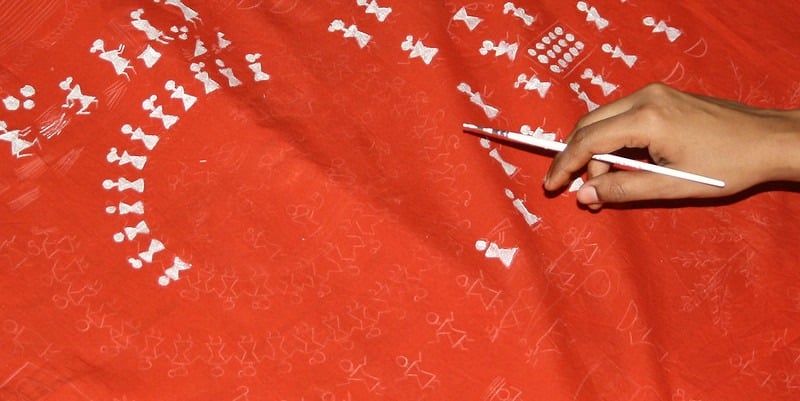
As I was walking around alone during the afternoon napping hours, observing the wide variety of Warli art, I started thinking about what makes warli so different from other art forms. I was told that unlike other forms of folk art in India, warli art depicts the realities of the Warli tribe rather than mythological ideas. You can find art depicting special events like marriages and harvests or an everyday scene representing life in the village. The art form is traditionally practiced on mud walls slathered with cow dung giving a brownish-green backdrop with the white pigment made from rice paste. Warli art glows in its simplicity and minimalist nature.
Human beings are made by joining the tips of two triangles to make people’s bodies. Men and women are drawn almost identically in warli art, with the only identifying features being the circular bun-like structure on the head or the wider lower triangle for women. You can find many loose elements from the Warli lifestyle in their art, like animals, trees and plants, harvests, tarpa dancing and farming.
“ What makes Warli different from other art forms is the simplicity, symbolism and repetitive nature of the art. It is very easy to master and makes art accessible to everyone. Everyone says that art is in everyone, but the people from Warli village actually make it become a reality. “
Shyamla (Resident of Walvanda)
The globalization of the tribal art
It’s time for the evening tea in the village of Warli art. I was invited to a hut adorned with white on the outside. On the threshold of the hut was Lata ji, a very old woman sitting on the floor in a roughly wrapped saree around her, and she handed me a cup of tea with some rusk. Keshav explained to me that she had seen me all morning with a notepad in my hand, looking at the art, and wanted to speak to me. As she began talking, I started to get worried because I did not understand a word in the language she spoke. But Keshav was nice enough to translate the story that she was telling me.
“The tribe was a very close knot and had shunned the modernization happening around them. Married women traditionally practiced warli art as an expression of their joy. But things changed in the 1970s when a man called Jivya Soma Mashe started to paint on canvas paper. And the reason for painting also changed from tradition to making art. He was the one who became the reason for the popularisation of art into modern culture.”
As the art form reached the rest of the world, it became influenced by it. It slowly started catching on to paper and modern elements in the painting. Artists started using brownish-green paper and even cloth to make art. Modern elements like bullock carts, cycles, buildings, and computers became a part of it. The dots and dashes used to make lines are transformed into straight lines. This tradition suddenly took a turn and became a prevalent art among people of the world.
Its popularity is owed to its simplicity and easiness of mastering. The art form conveys many stories, lifestyles, concepts, philosophies, and beliefs in a way that even children can use it to express themselves. Within no time, you could see glances of warli art around you without even knowing where it came from.
Warli art- Selfless gift to the world
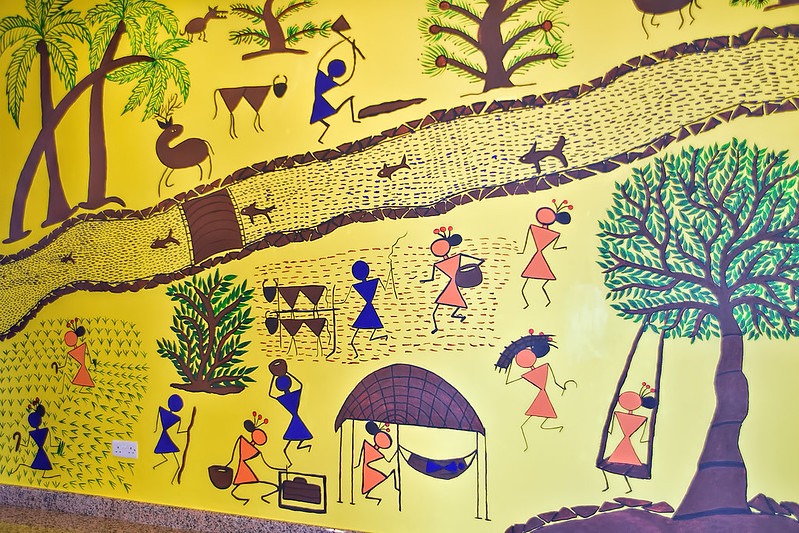
When Lata ji was telling us the story, I couldn’t help but notice how she didn’t look pleased about it. So, I did the most obvious thing to do and asked Keshav about it later. He told me about the realities of the Warli tradition since the commercialisation of Warli art. The people of the tribe aren’t very happy about the modernisation of the art form, especially the older generations. Earlier, warli was a tradition, a way to preserve their culture, and it was sacred. Only married women would paint it to reach out to the Gods for their blessings. But people of the tribe now felt like their culture had been reduced to “just paintings that look pretty”. Warli men have now started painting on canvases and paper for money, and the essence of the tradition is gone.
Even the people who earn money by selling warli art aren’t benefitted from the globalization of the art form. On one hand, the simplicity makes it popular, and on the other hand, it makes it easy to copy without giving due credit to the actual artists of the paintings in Walvanda village. Because the origin of Warli art is not well-known, people hardly own any original work from the village and the artists don’t get the recognition they deserve. You can buy original warli art and get in touch with people from the tribe using this link.
Warli art and its impact on Indian tourism
Warli has contributed quite a bit towards tourism in Maharashtra. When in Maharashtra, especially Mumbai, you will see warli art everywhere! It is on the buses, the sidewalks, on merchandise, hotels and even offices. In fact, many schools in the state also organise warli painting workshops for the students. The Maharashtrian government has officially made warli art a symbol of the state, and I understand why. My trip to the Warli village was enlightening, and somehow, I feel more connected to my nation and my culture and have more respect for tradition. There is something about the village air that makes my heart swell with joy.
Why visit Walvanda, the Warli village in India?
Just 130 km away from the metro city of Mumbai, the tiny village holds space for a peaceful weekend getaway. The landscape is lush green and filled with trees during the drive, and the promise of the good old days just makes it better. The drive is fast and takes just short of 3 hours.
Things to experience in Walvanda:
- Learn about the tribal art form “Warli” from the people who are closest to it. You can also get training in the authentic art form and experience the delight of simple living.
- You can also spend time in the rice paddy fields helping the farmers and experiencing life in a village. Farming is said to be a meditative process, and you can easily find peace away from the hustle and bustle of Mumbai.
- Participate in the Tarpa dance and learn how to express yourself in the most organic way possible. You can mingle with the local members of the tribe and dance with them.
- Learn about the best-kept secrets of the Warli tribe. From century-old recipes to their secret to healthy living, there is much to learn from them.
How to reach?
By train- There are no trains within the town. The best way is to reach Mumbai and then take a cab to Walvanda village. You can get a train to Mumbai from anywhere in the country. Check the IRCTC site for the latest train timings.
By air- The nearest airport is the Chhatrapati Shivaji Maharaj Airport in Mumbai. You can get a flight to Mumbai and book a cab from the airport to Warli village.
By road- A road trip is always fun. Because it is a small village with limited connectivity, roads are the best way to travel to Walvanda. You can book a Savaari from anywhere in the country to Walvanda and have a cost-effective and comfortable travel experience.
The government has given warli art the status of a registered cultural intellectual property of the tribal community, and you can find elements from warli art everywhere around you. But still, the name of the art, the culture and the people behind it are still pushed to the sidelines. A trip to the Walvanda village made me realise the importance of worldwide recognition and appreciation for traditions. What sets warli art apart from other art forms is its simplicity and easiness of it, and that may be one of the reasons why the people behind the art are not given the recognition they deserve. But another thing that I learnt is that although it is easy to push the background of the art form away, once you see the original warli being made in the village, settling for the unauthentic pieces becomes more challenging.
Last Updated on January 17, 2024 by
